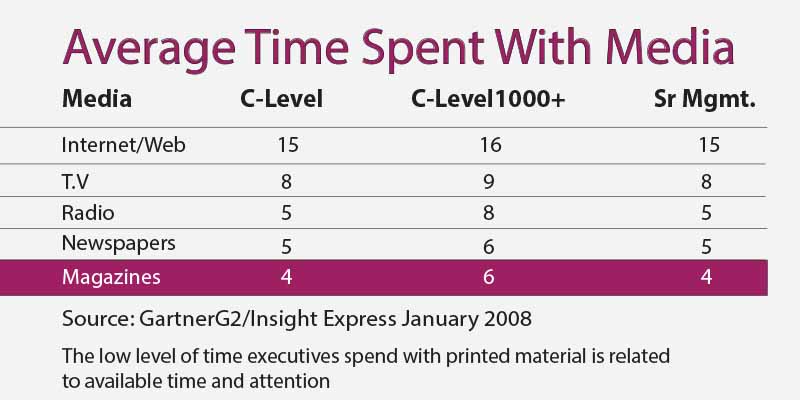
Image source
How To Copywrite White Papers That Extremely Busy Executive Read
Do you know how to write a white paper that extremely busy decision-makers eagerly want to read?
Are you trying hard to figure out how to get C-level decision-makers (CEOs, CIOs, CFOs, etc.) to read the authority report that you wrote for your clients?
It is no surprise that many decision-makers get valuable and cutting-edge solutions that help them stay on top of their niche simply from reading white papers.
They love the insight they get from those authority reports because it helps position them as thought leaders in their niche.
And it keeps them competitive too.
But C-level professionals are extremely busy and focused people.
They have high standards to determine what is worth their time.
And they have little patience and time to sift through the poorly crafted white paper.
Also, their busy workloads prevent them from reading poorly formatted traditional text-rich authority reports crafted by copywriters.
But unfortunately, the traditional all-text-rich authority report requires too much time to read and understand.
Therefore, a copywriter must find out all he can about why decision-makers are not reading their long-form content.
And then figure out how to produce an alternative to the old traditional text-heavy authority reports that busy executives don't want to read.
In this article, first, you will learn why executives are just too busy to read your authoritative report.
You will also learn what copywriters need to learn about busy executives before crafting white papers for them.
And finally, you will learn how to craft a white paper that extremely busy decision-makers will find compelling to read.
Let's dive in.
First of all, why are executives not reading authority reports as often as they used to?
Why Decision Makers Are Too Busy To Read White Papers

Today, most leaders are busy.
It seems that business leaders have way too much to do, tons of things on their plates, and just too much going on.
Even leaders who are not necessarily busy may artificially inflate their task list to appear more important than they already are.
For some, appearing busy has become a status symbol.
But the genuinely busy executives have become the default decision-makers in their company.
So they spend time on minor tasks that demand their constant attention.
That prevents them from reading an authoritative report.
Also, time spent on social media has increased their workloads and decreased the available time to read large, complex documents.
But on the other hand, almost every traditional authority report requires a lot of time to read.
Worse still, traditional white papers fail to engage busy readers with limited time and a short attention span.
The result is that busy executives don't have the time to read authority reports that offer solutions that address the pain points of their business.
However, understanding why decision-makers are too busy to read most white papers will help you to craft one that they would read.
Having said that:
The primary challenge that all white paper copywriters have is how to craft white papers that these busy executives can read.
What Copywriters Should Know About Busy Executives
Corporate decision-makers desperately need the solid information that white paper provides to solve their business problems and make the right buying decisions.
But they don’t have nearly enough time or patience to read every content that comes across their desks.
And so they need to make quick, and smart decisions on how best to use their valuable and very limited reading time.
To be sure, copywriters need to understand that busy decision-makers want to read their white papers because it helps position them as thought leaders and generate leads.
But the big elephant in the room is, why are they not reading them?
The quick answer is that most outsourced white papers are not written and produced in a way that appeals to busy executives.
Here is what white paper copywriters need to know about busy decision-makers:
- Length of the white paper: While the traditional 15 to 20-page white paper was an easy read for executives a few years ago, it is challenging for decision-makers with a busy work schedule.
- Design and formatting: Busy executives don't like to read authority papers without good formatting elements like summaries, bullets, sidebar callouts, and relevant graphics. And as scanners, they get frustrated sifting through countless pages of text and data-heavy information for solutions to their pain points.
- How information is presented: Information has to be presented from a compelling and unique angle to gain the attention of top-level executives. That means crafting fresh and original content that addresses their pain points. Give them what they want to read.
- Reach them through their peers: C-suite audiences prefer learning from each other. That means your goal should be to use their peers to engage with them. For instance, you can interview subject matter experts that your C-level audience wants to learn from.
- Focus on board-level issues: For busy executives to read the authoritative report, it must offer solutions to the top-of-mind of their pain points. For instance, the top five business priorities for executives according to ITSMA research are:
- Cutting costs
- Growing revenue
- Increasing productivity
- Transforming to enable digital business
- Upgrading infrastructure to enable remote work and collaboration
Now that you know more about busy executives, their pain points, and the kind of content that appeals to them, let's learn how to copywrite content that compels them to read.
How To Craft A White Paper That Extremely Busy Decision-Makers Will Read

Image source
Crafting authoritative reports that busy executives desire to read is a significant challenge.
A new approach to white paper copywriting is needed to overcome that challenge.
Copywriters can copy the concise delivery methods that news, entertainment, and social media writers use when crafting authoritative reports.
For instance, busy decision-makers no longer read newspaper articles, instead, they scan headlines.
And not only that, but they watch short TV sound bites instead of lengthy interviews.
Also, they prefer short tweets to long email messages.
Therefore, to gain their attention, copywriters must transform their white papers into engaging, compelling, and attention-oriented communications.
Incorporating these seven simple elements into your white paper copywriting will get your target audience to read:
These seven elements are:
- The Executive Summary
- The Concluding Summary
- Callouts/Pull Quotes
- Good Design And Graphics
- Bullet Lists
- Shaded Text Boxes
- Call To Action
1. The Executive Summary
The copywriter puts together a lot of background from various sources: client materials, SME interviews, and independent research after the kickoff call.
Now, all the research from all the sources is put together into a concise summary of the white paper for the client’s team to review.
So, what is an executive summary?
An executive summary, or management summary, is a single-page (or less) summary of what your white paper is all about.
It is best written as a first draft so that all reviewers can comment on it before the main writing starts.
Being a one-page summary, even the busiest executive can usually find time to read and comment on it.
Now, if the reviewers have differences in their opinions, they can resolve them during their internal discussions.
Having the executive summary written early in the process gives the client and writer time to review and refine it until all reviewers approve the proposed direction.
However, the two types are:
- A preview is like a movie trailer. It offers exciting highlights from the white paper without giving away the ending. The purpose is to entice the target audience to read the whole document.
- A synopsis-style executive summary is a brief argument of the white paper in condensed form.
An executive summary is a concise document about the whitepaper.
It encourages the reader to continue to the meat of the content while providing just enough detail for the satisfaction of a busy executive.
Above all, the executive summary convinces its readers that the authoritative report offers a solution to their pain points.
A well-written white paper with logical arguments provides a solid incentive for its target audience to read most of it.
In other words, if it accurately identifies the current pain points of the business and provides persuasive solutions, decision-makers are likely to read the whole white paper.
2. The Concluding Summary

Image source
The concluding summary is a rundown of the information from the white paper. It emphasizes the selling points again to make them memorable.
And it also connects the main points and theme of your authoritative report.
The concluding summary motivates your readers and prompts them to take your desired action at the end of your authoritative report.
However, for busy executives who like to scan, the concluding summary provides a piece of valuable information that deserves greater attention.
After scanning the concluding summary, busy decision-makers may advance to a more detailed reading stage, where they learn about the solutions highlighted in the white paper.
3. Callouts/Pull Quotes
Busy executives rarely read through the whitepaper.
Callouts and quotes provide focus anchors so that your target audience can read certain parts of the content.
A pull quote is a small selection of text in written content that is pulled out and quoted in a different format.
Pull quotes provide a teaser that entices the reader into the story.
Therefore, they increase reading and are juicy enough to convince readers who have already decided to skip the story to give it another chance.
On the other hand, a callout is a short text set in a larger font than the rest of the page and intended to attract attention.
It is often one of the first things noticed on any page of a white paper because it sits alone in an open white space within the sidebar margins.
Callouts and pull quotes are likely to be noticed and read, leading to greater reader engagement.
4. A Good Design And Graphics

Image source
A good design and graphics enhance the authoritative report instead of drawing attention to itself.
On the other hand, poor design and graphics can prevent busy executives from reading your compelling and persuasive text-rich authoritative report.
That said, your design must add value and clarity to that content instead of adding distractions.
And graphics make complex issues simple through illustrations and visualization.
While your white paper may have exceptionally worded text, writing style alone is not enough to engage today’s busy decision-makers.
Incorporate document design elements, concept/business graphics, and illustrations to gain the attention of your busy readers.
Good design and graphics draw readers right into the content and help them understand their pain points.
5. Bullet Lists
Busy readers love bullet lists because they’re light and lively, short and simple.
Use them to add the fastest and easiest flavor to your white paper.
They help readers to see and understand all the elements that make up a complex issue.
Just like callouts and pull quotes, bullets are another effective way of gaining the reader's attention.
And that's because bulleted items stand out from the standard paragraphs presented on the page.
Bulleted lists instinctively draw the attention of busy readers, making them a great way to highlight important information.
Because decision-makers are extremely busy, it has become an excellent way to deliver information.
6. Use Shaded Text Boxes
Shading is the color or artistic design you use as a background for a paragraph.
Shaded text boxes provide readers with bottom-line summary statements and enhance the reading experience.
By shading one or more paragraphs of text, you can effectively distinguish bottom-line statements from the remaining text on the page.
It is especially effective with busy readers who scan a whole white paper on initial review.
When used correctly, the shaded area of the white paper will have a greater chance of being noticed and read than a portion of bold or italicized text.
If used effectively, a busy executive that scans content will read the information within these text boxes.
7. Call To Action
As a white papers copywriter, never leave this most important section out or fumble it at the end.
Tell busy executives emphatically what you want them to do and how to do it.
Offer the decision-makers a free trial version, free assessment, gift certificate if you call today, that sort of thing.
End your white paper with a bang.
Final Thoughts
Traditional white papers are not effective for today's busy decision-makers.
And that's because executives are just too busy to read your authoritative report.
The article helped you learn about busy decision-makers and how to craft a white paper that extremely busy decision-makers find compelling to read.
By following the steps outlined in this article, you too can craft a white paper that is engaging and compelling.
Yes, one that extremely busy executives will read.
Need more people to read your white papers? Contact us today to learn how you can turn decision-makers from yawners to page-turners.
 WhatsApp us at: +234 080 331 75396 or +234 080 579 37786
WhatsApp us at: +234 080 331 75396 or +234 080 579 37786

















